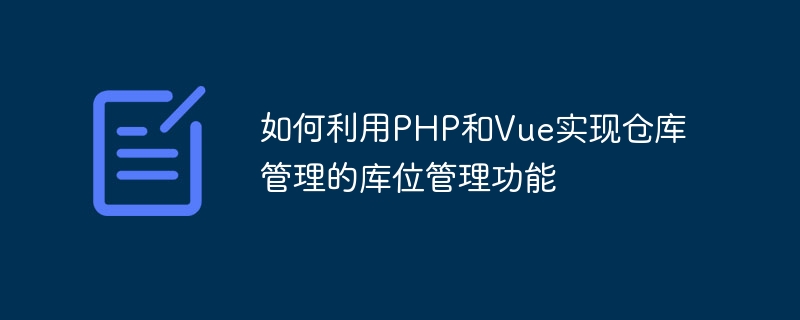

How to use PHP and Vue to implement the location management function of warehouse management
Introduction:
Warehouse management refers to the standardized and efficient management of items in the warehouse manage. Among them, storage location management is an important part of warehouse management, which involves the allocation, query, adjustment and other functions of storage locations. This article will introduce how to use PHP and Vue to implement the location management function of warehouse management, and provide specific code examples.
1. Technology Selection
In order to realize the location management function of warehouse management, we choose PHP as the back-end development language and use Vue as the front-end framework. PHP is an object-oriented scripting language with rich libraries and extensions that can easily interact with databases. Vue is a progressive framework for building user interfaces. It is easy to learn and use, and has efficient data binding and componentization features.
2. Database design
In order to support the location management function, we need to design a suitable database structure. A simple location management system can contain two tables: location table (location) and item table (item). The storage location table saves all storage location information in the warehouse, including storage location number, location type, warehouse to which it belongs, and other fields. The item table saves the item information stored in the storage location, including fields such as item number, item name, and location. The specific database design can be adjusted according to actual needs.
3. Back-end development
<?php
// 数据库连接配置
$host = "localhost";
$username = "root";
$password = "password";
$database = "warehouse";
// 创建数据库连接
$conn = new mysqli($host, $username, $password, $database);
// 检查连接是否成功
if ($conn->connect_error) {
die("数据库连接失败: " . $conn->connect_error);
}
?> (1) Adding a library location
You can add a library location by writing a PHP script. Specific steps include receiving the location information passed by the front end, executing SQL statements to insert the location information into the location table, and returning success or failure results to the front end.
<?php
// 接收前端传递的库位信息
$locationNumber = $_POST['locationNumber'];
$locationType = $_POST['locationType'];
$warehouse = $_POST['warehouse'];
// 执行SQL语句将库位信息插入到库位表中
$sql = "INSERT INTO location (locationNumber, locationType, warehouse) VALUES ('$locationNumber', '$locationType', '$warehouse')";
$result = $conn->query($sql);
// 返回结果给前端
if ($result) {
echo "库位添加成功";
} else {
echo "库位添加失败: " . $conn->error;
}
?> (2) Query of warehouse location
You can realize the query function of warehouse location by writing a PHP script. Specific steps include executing SQL statements to query the location information in the location table, and returning the query results to the front end.
<?php
// 执行SQL语句查询库位表中的库位信息
$sql = "SELECT * FROM location";
$result = $conn->query($sql);
// 返回结果给前端
if ($result->num_rows > 0) {
$locations = array();
while ($row = $result->fetch_assoc()) {
$locations[] = $row;
}
echo json_encode($locations);
} else {
echo "没有查询到库位信息";
}
?> (3) Storage location adjustment
You can realize the storage location adjustment function by writing a PHP script. Specific steps include receiving the location number and target warehouse passed by the front end, executing SQL statements to update the location information in the location table, and returning a success or failure result to the front end.
<?php
// 接收前端传递的库位编号和目标仓库
$locationNumber = $_POST['locationNumber'];
$targetWarehouse = $_POST['targetWarehouse'];
// 执行SQL语句更新库位表中的库位信息
$sql = "UPDATE location SET warehouse = '$targetWarehouse' WHERE locationNumber = '$locationNumber'";
$result = $conn->query($sql);
// 返回结果给前端
if ($result) {
echo "库位调整成功";
} else {
echo "库位调整失败: " . $conn->error;
}
?>4. Front-end development
When using Vue to implement the location management function of warehouse management, we need to write HTML templates and Vue components to implement functions such as adding, querying, and adjusting location locations.
<!DOCTYPE html>
<html>
<head>
<meta charset="UTF-8">
<title>仓库管理</title>
</head>
<body>
<div id="app">
<h2>库位管理</h2>
<form>
<input type="text" v-model="locationNumber" placeholder="库位编号">
<input type="text" v-model="locationType" placeholder="库位类型">
<input type="text" v-model="warehouse" placeholder="所属仓库">
<button @click="addLocation">添加库位</button>
</form>
<ul>
<li v-for="location in locations">
{{ location.locationNumber }} - {{ location.locationType }} - {{ location.warehouse }}
<input type="text" v-model="targetWarehouse">
<button @click="adjustLocation(location.locationNumber)">调整库位</button>
</li>
</ul>
</div>
<script src="https://cdn.jsdelivr.net/npm/vue/dist/vue.js"></script>
<script src="app.js"></script>
</body>
</html>// app.js
new Vue({
el: '#app',
data: {
locationNumber: '',
locationType: '',
warehouse: '',
locations: [],
targetWarehouse: ''
},
methods: {
addLocation() {
// 发送POST请求添加库位
axios.post('addLocation.php', {
locationNumber: this.locationNumber,
locationType: this.locationType,
warehouse: this.warehouse
}).then(response => {
alert(response.data);
this.locationNumber = '';
this.locationType = '';
this.warehouse = '';
}).catch(error => {
console.error(error);
});
},
adjustLocation(locationNumber) {
// 发送POST请求调整库位
axios.post('adjustLocation.php', {
locationNumber: locationNumber,
targetWarehouse: this.targetWarehouse
}).then(response => {
alert(response.data);
}).catch(error => {
console.error(error);
});
},
loadLocations() {
// 发送GET请求查询库位
axios.get('getLocations.php').then(response => {
this.locations = response.data;
}).catch(error => {
console.error(error);
});
}
},
mounted() {
// 获取并显示库位信息
this.loadLocations();
}
});The above are relevant code examples on how to use PHP and Vue to implement the location management function of warehouse management. The back-end interface is implemented through PHP to implement functions such as adding, querying, and adjusting storage locations; the front-end interface is implemented through Vue to implement data binding and interaction. Readers can further optimize and expand the code according to actual needs to achieve a more complete warehouse management system.
The above is the detailed content of How to use PHP and Vue to implement the location management function of warehouse management. For more information, please follow other related articles on the PHP Chinese website!